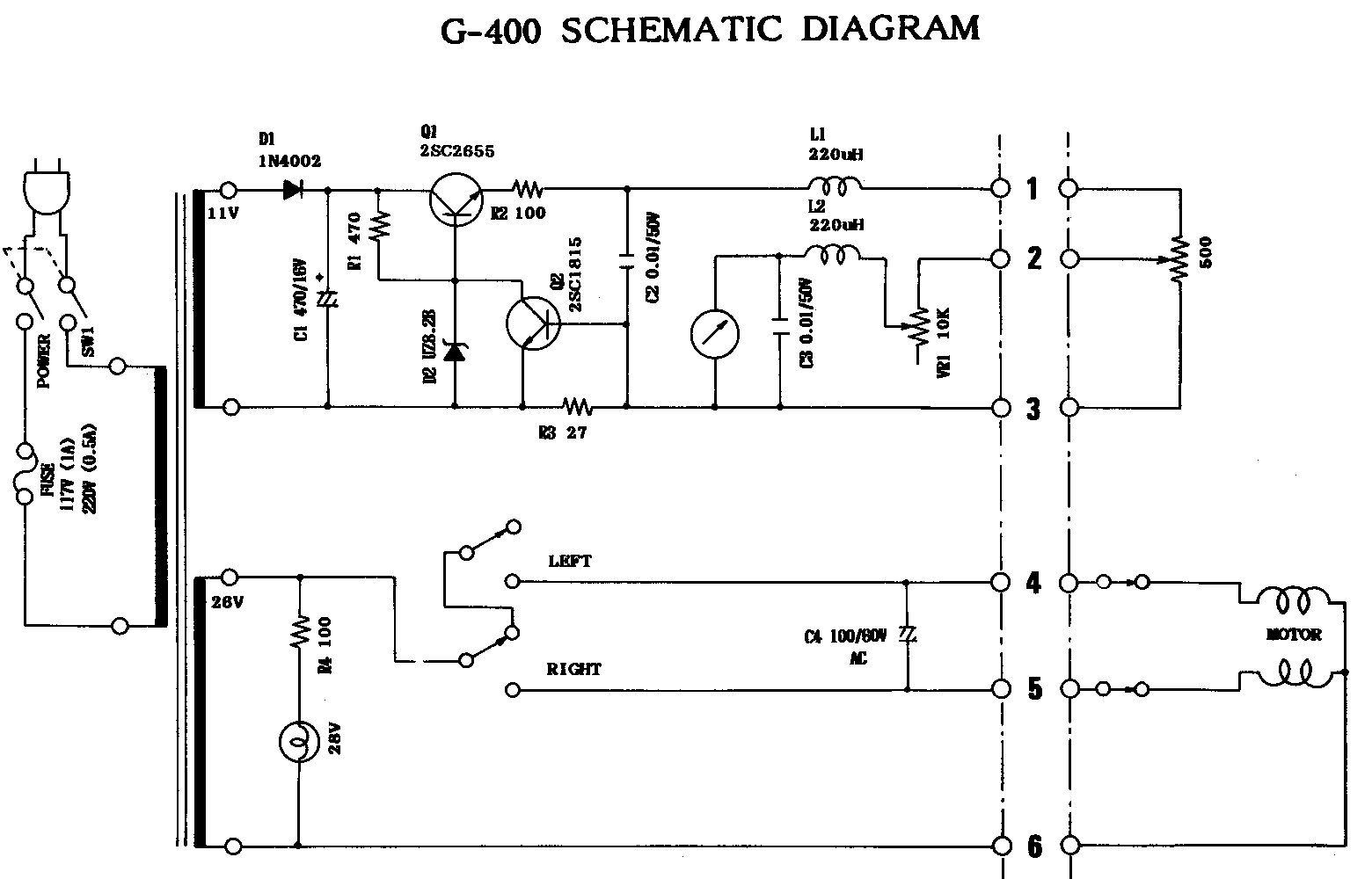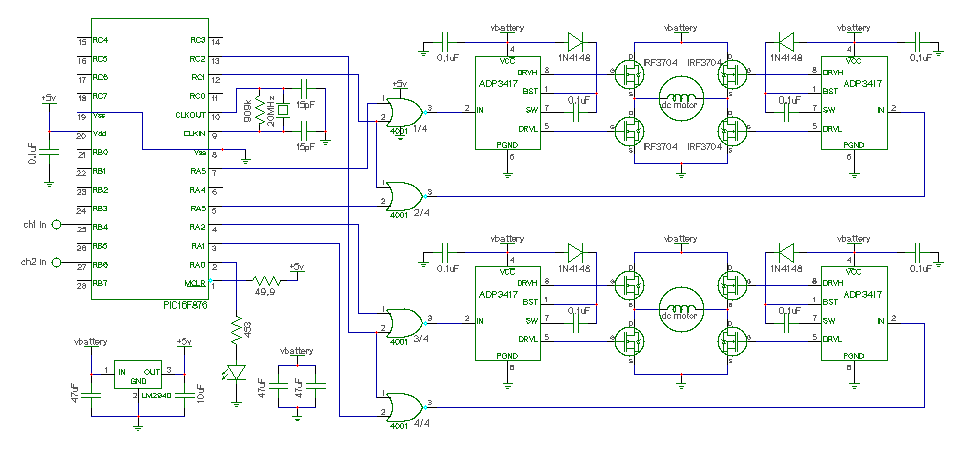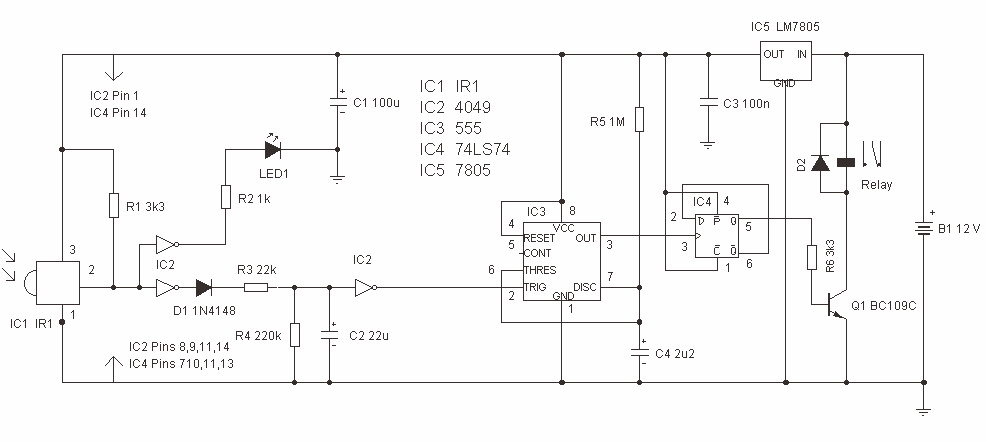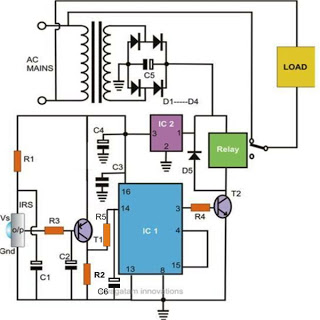
Remote control Infrared Jammer
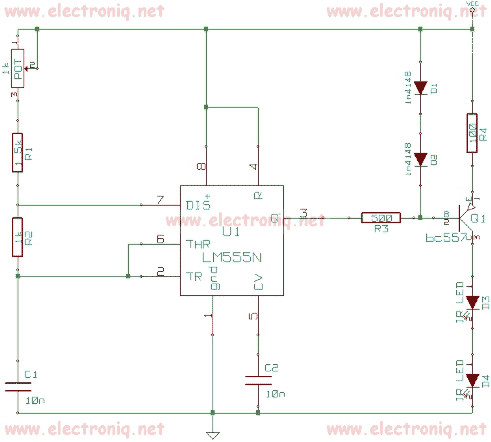
This Remote control Jammer device is useful when blocking someone from using the remote control (such as children who frequently change the channels on the TV). This remote control jammer is very simple and uses two infrared LEDs that continuously transmit at a frequency between 32 and 41 kHz (most remotes operate at 36 and 38 kHz). The automatic gain control of the receivers reduces the gain due to the strong signal from the two IR LEDs, making any signals from a remote control too weak to be detected by the receiver.
More: The device is based on an oscillator using an LM555 timer IC. The settings for this remote jammer are simple: the P1 potentiometer must be adjusted until the remote control ceases to function. This device operates on a 9 volts DC current.
The remote control jammer circuit utilizes an LM555 timer configured in astable mode to generate a continuous square wave signal. This square wave oscillates at a frequency that interferes with the infrared signals typically used by remote controls. The two infrared LEDs are connected in parallel and driven by the output of the LM555 timer, ensuring that they emit a strong infrared light that saturates the receiver of the remote control.
The LM555 timer is powered by a 9V DC power supply, which is a common voltage for many electronic devices. The circuit includes a P1 potentiometer, which allows for fine-tuning of the frequency output of the timer. By adjusting this potentiometer, the frequency can be shifted slightly to ensure maximum interference with the target remote control frequencies.
Additionally, the circuit may include bypass capacitors to stabilize the power supply to the LM555 timer, ensuring consistent operation. The output from the timer can be connected to a simple driver circuit, such as a transistor amplifier, if higher current is required to drive the infrared LEDs effectively.
The overall design prioritizes simplicity and effectiveness, making it an accessible solution for those needing to prevent unauthorized use of remote controls in a household environment. Safety considerations should be noted, as the device should be used responsibly and in accordance with local regulations regarding signal jamming devices.This Remote control Jammer device it’s useful when we need to block someone to use the remote control (children that change frequently the channels at tv). This remote control jammer it’s very simply and it use two infrared Leds which continuously transmit with a frequency between 32 and 41 Khz ( most of remote works at 36 and 38 Khz).
The automatic gain of the receivers reduces the gain of the receiver due the strong signal from that two IR leds and any signals from a remote control are too weak to be detected by receiver . The device it’s based on an oscillator based on a Lm555 timer IC . The settings for this remote jammer are simply : we need to modify the P1 potentiometer until the remote control don’t work . This device use a 9 volts Dc current . 🔗 External reference
More: The device is based on an oscillator using an LM555 timer IC. The settings for this remote jammer are simple: the P1 potentiometer must be adjusted until the remote control ceases to function. This device operates on a 9 volts DC current.
The remote control jammer circuit utilizes an LM555 timer configured in astable mode to generate a continuous square wave signal. This square wave oscillates at a frequency that interferes with the infrared signals typically used by remote controls. The two infrared LEDs are connected in parallel and driven by the output of the LM555 timer, ensuring that they emit a strong infrared light that saturates the receiver of the remote control.
The LM555 timer is powered by a 9V DC power supply, which is a common voltage for many electronic devices. The circuit includes a P1 potentiometer, which allows for fine-tuning of the frequency output of the timer. By adjusting this potentiometer, the frequency can be shifted slightly to ensure maximum interference with the target remote control frequencies.
Additionally, the circuit may include bypass capacitors to stabilize the power supply to the LM555 timer, ensuring consistent operation. The output from the timer can be connected to a simple driver circuit, such as a transistor amplifier, if higher current is required to drive the infrared LEDs effectively.
The overall design prioritizes simplicity and effectiveness, making it an accessible solution for those needing to prevent unauthorized use of remote controls in a household environment. Safety considerations should be noted, as the device should be used responsibly and in accordance with local regulations regarding signal jamming devices.This Remote control Jammer device it’s useful when we need to block someone to use the remote control (children that change frequently the channels at tv). This remote control jammer it’s very simply and it use two infrared Leds which continuously transmit with a frequency between 32 and 41 Khz ( most of remote works at 36 and 38 Khz).
The automatic gain of the receivers reduces the gain of the receiver due the strong signal from that two IR leds and any signals from a remote control are too weak to be detected by receiver . The device it’s based on an oscillator based on a Lm555 timer IC . The settings for this remote jammer are simply : we need to modify the P1 potentiometer until the remote control don’t work . This device use a 9 volts Dc current . 🔗 External reference


